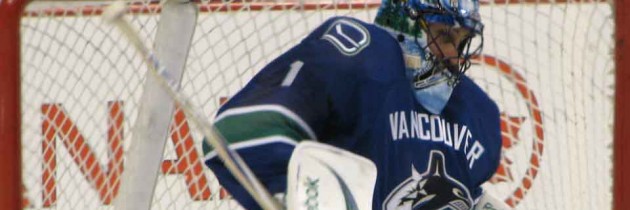J-Curving Your Teachers
by Bill de Jager, SCSBC Director of Learning ◊
Don’t kid yourself, when an organization invests a million dollars or more in one of their people, they expect real books to be kept — and kept substantially. Coach Vigneault has his thick tome on Roberto, Roberto has his own copious copy, and there are, for sure, another 29 more books – every NHL team has their own voluminous book on R.L. to help their players score on him.
Those books are fat-full of analyzed stats, candid observations, brutal self-reflections, goals achieved, goals to be achieved, trends, predictions, constructive critique and appropriate affirmations. Those books serve as a critical driver in the on-going implementation of expected improvement and excellence.
An NHL hockey coach’s primary task is to lead a school of skaters to victory. There can be no bell curve approach at this level: no acceptance of expected failure for a few, mediocrity for most, and excellence for an elite.
At this level, all are J-curved: proficiency is presumed;
improvement is implicit; excellence is expected.
So now, some questions.
Is your school community committed to providing an exceptional learning environment for your students?
Then give them outstanding teachers;1 give them a school teeming with exceptional teachers. And who’s responsible for nurturing such proficient people? Your principal, of course.
The primary task of principals is to J-curve teachers. No more; no less. A significantly large proportion of their time is “to teach the teachers.”2 Much less time on operations, paperwork and parents; less on crisis and management; less on students. “Great principals focus on students — by focusing on teachers.”3
That intentional focus has much merit, considering the substantial investment a school community makes in each of its teachers. For each teacher, it can be a $1,000,000 investment. Consider a teacher who serves a school for 20 years at an annual wage and benefit package of about $50,000. Did you do the math? They’re worth keeping books for, aren’t they?
So what might those books look like?
At thin minimum, you should find current summative evaluations. Yet, a book’s thick richness would be found in its self-reflections; its goals set and met; its growing list of learning opportunities attended and implemented; its clear self-articulation of required improvement; and a principal’s continuous observations, critique and affirmations. Such books would be a collection of critical working documents – assessments for learning – designed to hone the multitude of components and skills that make good teachers into masters.
Regretfully, without consistent and intentional guidance, some of our teachers continue to weight-lift certain self-loved instructional practices to such an extent that their teaching has deformed into one pedagogical muscle bulge while other important practices atrophy. Being a master at one pedagogy but deficient in most others isn’t conducive to respecting differentiation in the classroom. Facilitating over-all instructional fitness is the focus of each teacher’s personal educational trainer – the principal.
How does a principal make J-curving happen?
By constantly being where the learning is happening – where the teachers are. By watching, listening, observing, team-teaching and learning. Being a master teacher and the lead learner. Keeping the books.
Defaulting our teachers to a bell-curve of expectations shouldn’t be an option; it’s just too costly when it comes to our students’ learning. Let’s J-curve our teachers upwards from good to great!
Footnotes:
1 Todd Whitaker, What Great Principals Do Differently: Fifteen Things That Matter Most, p. 35.
2 Ibid.
3 Ibid.
Discussion questions
Who’s keeping the books?
What do the books look like?
How are the books being used?
Are we bell-curving or J-curving our teachers?

